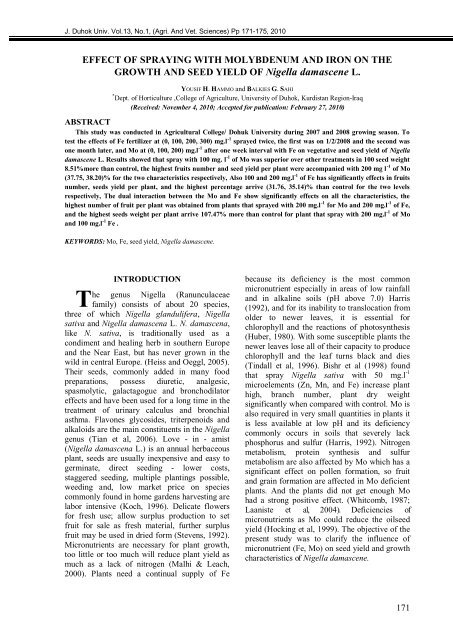The Influence Of Priming Two Cucumber Cultivar Seeds
The Influence Of Priming Two Cucumber Cultivar Seeds
The Influence Of Priming Two Cucumber Cultivar Seeds
You also want an ePaper? Increase the reach of your titles
YUMPU automatically turns print PDFs into web optimized ePapers that Google loves.
J. Duhok Univ. Vol.13, No.1, (Agri. And Vet. Sciences) Pp 171-175, 2010<br />
EFFECT OF SPRAYING WITH MOLYBDENUM AND IRON ON THE<br />
GROWTH AND SEED YIELD OF Nigella damascene L.<br />
YOUSIF H. HAMMO and BALKIES G. SAHI<br />
* Dept. of Horticulture ,College of Agriculture, University of Duhok, Kurdistan Region-Iraq<br />
(Received: November 4, 2010; Accepted for publication: February 27, 2010)<br />
ABSTRACT<br />
This study was conducted in Agricultural College/ Dohuk University during 2007 and 2008 growing season. To<br />
test the effects of Fe fertilizer at (0, 100, 200, 300) mg.l -1 sprayed twice, the first was on 1/2/2008 and the second was<br />
one month later, and Mo at (0, 100, 200) mg.l -1 after one week interval with Fe on vegetative and seed yield of Nigella<br />
damascene L. Results showed that spray with 100 mg. l -1 of Mo was superior over other treatments in 100 seed weight<br />
8.51%more than control, the highest fruits number and seed yield per plant were accompanied with 200 mg l -1 of Mo<br />
(37.75, 38.20)% for the two characteristics respectively, Also 100 and 200 mg.l -1 of Fe has significantly effects in fruits<br />
number, seeds yield per plant, and the highest percentage arrive (31.76, 35.14)% than control for the two levels<br />
respectively, <strong>The</strong> dual interaction between the Mo and Fe show significantly effects on all the characteristics, the<br />
highest number of fruit per plant was obtained from plants that sprayed with 200 mg.l -1 for Mo and 200 mg.l -1 of Fe,<br />
and the highest seeds weight per plant arrive 107.47% more than control for plant that spray with 200 mg.l -1 of Mo<br />
and 100 mg.l -1 Fe .<br />
KEYWORDS: Mo, Fe, seed yield, Nigella damascene.<br />
T<br />
INTRODUCTION<br />
he genus Nigella (Ranunculaceae<br />
family) consists of about 20 species,<br />
three of which Nigella glandulifera, Nigella<br />
sativa and Nigella damascena L. N. damascena,<br />
like N. sativa, is traditionally used as a<br />
condiment and healing herb in southern Europe<br />
and the Near East, but has never grown in the<br />
wild in central Europe. (Heiss and Oeggl, 2005).<br />
<strong>The</strong>ir seeds, commonly added in many food<br />
preparations, possess diuretic, analgesic,<br />
spasmolytic, galactagogue and bronchodilator<br />
effects and have been used for a long time in the<br />
treatment of urinary calculus and bronchial<br />
asthma. Flavones glycosides, triterpenoids and<br />
alkaloids are the main constituents in the Nigella<br />
genus (Tian et al, 2006). Love - in - amist<br />
(Nigella damascena L.) is an annual herbaceous<br />
plant, seeds are usually inexpensive and easy to<br />
germinate, direct seeding - lower costs,<br />
staggered seeding, multiple plantings possible,<br />
weeding and, low market price on species<br />
commonly found in home gardens harvesting are<br />
labor intensive (Koch, 1996). Delicate flowers<br />
for fresh use; allow surplus production to set<br />
fruit for sale as fresh material, further surplus<br />
fruit may be used in dried form (Stevens, 1992).<br />
Micronutrients are necessary for plant growth,<br />
too little or too much will reduce plant yield as<br />
much as a lack of nitrogen (Malhi & Leach,<br />
2000). Plants need a continual supply of Fe<br />
because its deficiency is the most common<br />
micronutrient especially in areas of low rainfall<br />
and in alkaline soils (pH above 7.0) Harris<br />
(1992), and for its inability to translocation from<br />
older to newer leaves, it is essential for<br />
chlorophyll and the reactions of photosynthesis<br />
(Huber, 1980). With some susceptible plants the<br />
newer leaves lose all of their capacity to produce<br />
chlorophyll and the leaf turns black and dies<br />
(Tindall et al, 1996). Bishr et al (1998) found<br />
that spray Nigella sativa with 50 mg.l -1<br />
microelements (Zn, Mn, and Fe) increase plant<br />
high, branch number, plant dry weight<br />
significantly when compared with control. Mo is<br />
also required in very small quantities in plants it<br />
is less available at low pH and its deficiency<br />
commonly occurs in soils that severely lack<br />
phosphorus and sulfur (Harris, 1992). Nitrogen<br />
metabolism, protein synthesis and sulfur<br />
metabolism are also affected by Mo which has a<br />
significant effect on pollen formation, so fruit<br />
and grain formation are affected in Mo deficient<br />
plants. And the plants did not get enough Mo<br />
had a strong positive effect. (Whitcomb, 1987;<br />
Laaniste et al, 2004). Deficiencies of<br />
micronutrients as Mo could reduce the oilseed<br />
yield (Hocking et al, 1999). <strong>The</strong> objective of the<br />
present study was to clarify the influence of<br />
micronutrient (Fe, Mo) on seed yield and growth<br />
characteristics of Nigella damascene.<br />
171



